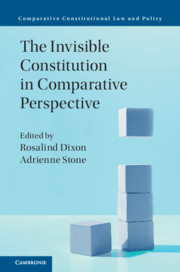Book contents
- The Invisible Constitution in Comparative Perspective
- Comparative Constitutional Law and Policy
- The Invisible Constitution in Comparative Perspective
- Copyright page
- Contents
- Contributors
- Part I Conceptualising the Invisible Constitution
- 1 The Invisible Constitution in Comparative Perspective
- 2 Soundings and Silences
- 3 Originalism and the Invisible Constitution
- 4 The Implicit and the Implied in a Written Constitution
- 5 The Centrality and Diversity of the Invisible Constitution
- 6 Interim Constitutions and the Invisible Constitution
- Part II The View from Asia Pacific and the Middle East
- Part III The View from Europe and North America
- Index
6 - Interim Constitutions and the Invisible Constitution
from Part I - Conceptualising the Invisible Constitution
Published online by Cambridge University Press: 02 November 2018
- The Invisible Constitution in Comparative Perspective
- Comparative Constitutional Law and Policy
- The Invisible Constitution in Comparative Perspective
- Copyright page
- Contents
- Contributors
- Part I Conceptualising the Invisible Constitution
- 1 The Invisible Constitution in Comparative Perspective
- 2 Soundings and Silences
- 3 Originalism and the Invisible Constitution
- 4 The Implicit and the Implied in a Written Constitution
- 5 The Centrality and Diversity of the Invisible Constitution
- 6 Interim Constitutions and the Invisible Constitution
- Part II The View from Asia Pacific and the Middle East
- Part III The View from Europe and North America
- Index
Summary
- Type
- Chapter
- Information
- The Invisible Constitution in Comparative Perspective , pp. 167 - 190Publisher: Cambridge University PressPrint publication year: 2018
- 2
- Cited by



